When starting a vegetable garden as a beginner, it’s important to plan carefully. Garden planning for a vegetable garden can be overwhelming, but with a few considerations, it can be made simpler. The first step is determining the space needed for the garden, whether it be in a traditional row garden, raised beds, or containers. Sun exposure is critical, with most vegetables requiring at least 6 hours of full sun per day.
Soil quality is another important consideration, with vegetables preferring loamy, well-drained soil. It is recommended to test the soil or add compost or topsoil to enrich it. Watering is vital, with most vegetables needing at least 2 inches of water per week. Basic gardening tools like a spade, garden fork, and hand weeder are necessary, along with a garden journal to keep track of planting and harvesting.
When planning a vegetable garden, it’s essential to consider the timing of planting as some vegetables prefer cooler weather while others thrive in warmer temperatures. It is advised to start small and choose easy vegetables to grow. Companion planting can be beneficial for pest control and attracting pollinators. Overall, starting a vegetable garden can be a rewarding experience for first-time gardeners.
Key Takeaways:
- Plan carefully by considering space, sun exposure, soil, water needs, and essential gardening tools.
- Use a garden journal to keep track of planting and harvesting.
- Start small and choose easy-to-grow vegetables.
- Consider companion planting for pest control and pollination.
Determining the Perfect Garden Space
Determining the perfect space for your garden is an important first step for beginners. When deciding how much space is needed for a vegetable garden, it is recommended to allocate 50 sq feet per person. This will provide enough room for a variety of vegetables while still being manageable in terms of maintenance.
Sun exposure is a crucial factor in selecting a suitable site for your garden. Vegetables need at least 6 hours of full sun daily to grow and produce well. It is best to choose a location that receives morning sun and afternoon shade to avoid scorching the plants.
| Soil Quality | Water Needs |
|---|---|
| Soil should be loamy and well-drained. Enriching the soil with compost or organic fertilizer can improve productivity. | Determining water needs is vital, with vegetables requiring at least 2 inches of water per week. It is best to water deeply and infrequently, rather than shallowly and frequently. |
Basic gardening tools like a shovel, fork, and hose are necessary for starting a garden. It is also helpful to keep a garden journal to keep track of planting and yields. Planning a garden involves considering the frost dates in the area and selecting high-quality seeds.
Picking the right location is crucial for the success of your garden. Factors like sunlight, drainage, wind exposure, and proximity to a water source should be taken into consideration. It is best to avoid planting in low-lying areas that may collect water or in areas that are prone to standing water.
Starting small is recommended for beginners. A 10′ x 10′ garden or a 4′ x 4′ raised bed are manageable sizes that will allow you to experiment with different vegetables and techniques. Choosing vegetables that are easy to grow and that the family enjoys eating is important, as is considering the availability of certain vegetables in local grocery stores.
Proper planning includes arranging plants based on their planting times and ensuring there is enough space for growth and maintenance. Companion planting can be implemented to provide pest control and attract pollinators. With these gardening basics in mind, beginners can confidently start their own garden and enjoy the rewards of fresh, home-grown produce.
Essential Gardening Tools for Beginners
Having the right gardening tools is essential for beginners to set themselves up for success. While there are many tools available, there are a few essential ones that every beginner should have. These include a tiller, spade, garden fork, soaker hoses, hoe, hand weeder, and wheelbarrow or bucket.
A tiller is used for breaking up soil and preparing it for planting. A spade and garden fork are used for digging and turning soil, while a hoe and hand weeder are used for removing weeds. Soaker hoses provide a gentle, consistent watering system, while a wheelbarrow or bucket is used to transport soil, mulch, and plants.
Before choosing specific tools, beginners should determine the size of their garden and the type of plants they plan to grow. It is also important to choose high-quality tools that are comfortable to use and made to last.
Good gardening tools can be an investment, but they are necessary for maintaining and cultivating a garden. With the right tools in hand, beginners can tackle any gardening project with confidence.
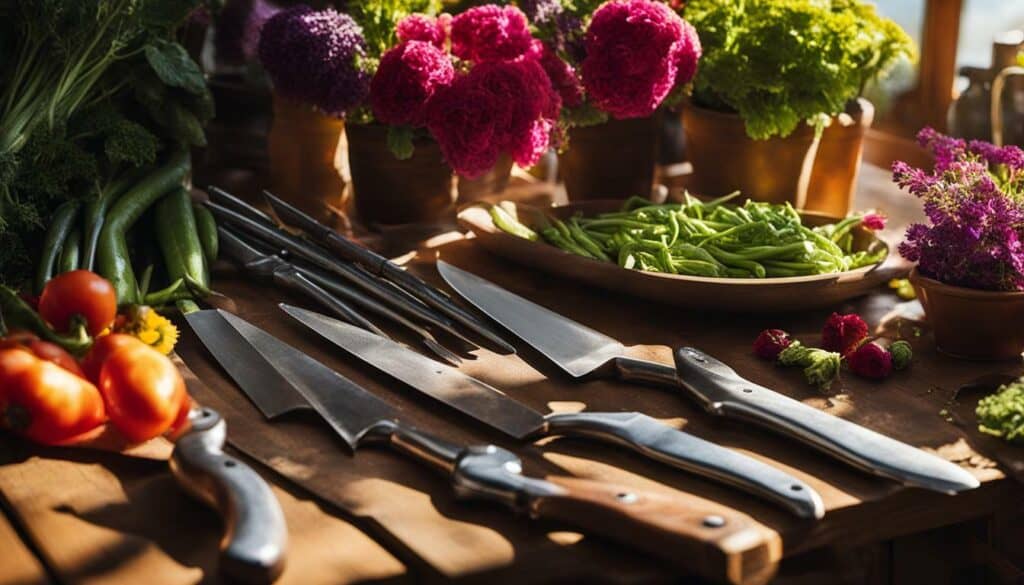
When starting a garden, beginners should also consider the layout and location. It is recommended to start with a manageable garden size, such as an 8×8 feet area, and choose a location that receives 6 to 8 hours of sunlight per day. The soil should be well-drained and nutrient-rich, and adding compost or organic fertilizer can help improve its quality. Beginners should also consider the water needs of their plants and have a watering system in place, such as a soaker hose.
When selecting vegetables to grow, it is important for beginners to start with easy-to-grow options like lettuce, green beans, radishes, tomatoes, zucchini, peppers, beets, carrots, chard, spinach, kale, and peas. These plants are beginner-friendly and provide a good foundation for learning about gardening.
Planning the layout of the garden is also crucial. Tall plants should be placed on the north side to prevent shading. Companion planting can also be beneficial in providing natural pest control and attracting pollinators.
Overall, beginners should start small and gradually expand their garden as they gain more experience. With the right tools, location, and plant selection, anyone can grow a beautiful and productive garden.
The Benefits of Keeping a Garden Journal
Keeping a garden journal is highly recommended for first-time gardeners to stay organized and track progress. A garden journal can serve as a valuable tool for tracking important information, such as the size and location of the garden, sun exposure, soil quality, and water needs.
| Track your planting progress | Record your gardening successes and failures | Aid in planning future gardens |
|---|---|---|
|
By keeping a journal, you can take note of what plants were grown and where, as well as which plants did well and which ones didn’t. This information can help you plan future gardens and maximize your harvest. |
Record your gardening successes and failures in your journal. Keeping records of your gardening process can be helpful in optimizing the outcomes of your next harvest. |
Your garden journal can be used as a guide for future garden planning. By referring back to your journal, you can keep track of what worked and what didn’t. This can also be a source of inspiration for future garden designs, allowing you to experiment with different plants and layouts. |
A garden journal can also be a source of enjoyment. Many gardeners find writing about their gardening experiences to be a relaxing and therapeutic activity. Writing about your gardening successes and challenges can also help you reflect on your personal growth as a gardener.
Overall, keeping a garden journal is a great way to stay organized and track progress in your gardening journey. Whether you’re a beginner or an experienced gardener, a garden journal can be a helpful tool in planning, recording, and enjoying your gardening experience.

Choosing Easy-to-Grow Vegetables
When planning what to plant in your beginner garden, selecting easy-to-grow vegetables is a smart choice. Consider factors such as the amount of space you need, the sun exposure required, and the quality of your soil. Aim to have 50 sq feet per person for a garden, and ensure that vegetables receive at least 6 hours of full sun every day.
Loamy, well-drained soil is ideal for vegetables, and you can enrich the soil by adding compost or quality topsoil. When selecting vegetables, start with easy-to-grow options like:
- Lettuce
- Green beans
- Radishes
- Tomatoes (by transplant)
- Zucchini
- Peppers (by transplant)
- Beets
- Carrots
- Chard
- Spinach
- Kale
- Peas
Consider the preferences and availability of vegetables at your local grocery store, as well as the time and effort required to care for each plant. Planning the layout of your garden and incorporating companion plants can also contribute to a successful harvest.
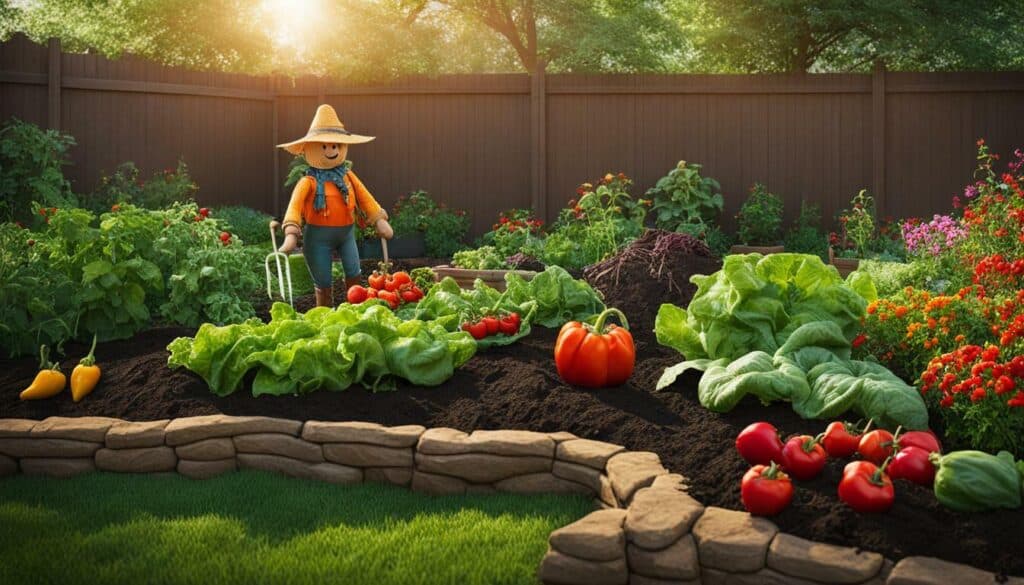
Start small and gradually expand your garden as you gain more experience. With proper planning and care, you can enjoy the satisfaction of growing your own fresh and healthy vegetables.
Meeting Specific Plant Requirements
Meeting the specific requirements of each plant is crucial for the success of your beginner garden. When planning your vegetable garden, it is important to consider several factors to ensure that your plants receive the necessary care and environment to thrive.
Space: The first consideration is the space required for your garden. The general rule is to allocate 50 square feet per person, which can be achieved through traditional row gardens, raised beds, or containers. Make sure to allow enough space between plants to ensure proper air circulation and avoid overcrowding.
Sun exposure: Vegetables need at least 6 to 8 hours of full sun each day. The orientation of garden rows should be north to south to maximize sun exposure. If your garden is in a shaded area, consider growing shade-tolerant plants or installing a shade cloth.
Soil quality: Vegetables prefer loamy, well-drained soil. Conducting a soil test can help determine its quality and whether any enrichments are necessary. Maintaining proper soil fertility through the addition of compost, organic fertilizers, and mulch is crucial.
Watering: Vegetables generally need at least 2 inches of water per week. Using a soaker hose system or capturing rainwater can help meet these needs. Be sure to water deeply and regularly, especially during hot, dry weather.
Choosing vegetables: It is important to consider personal preferences, the availability of produce in the local area, and the ability to care for the plants throughout the growing season. Some easy-to-grow vegetables for beginners include lettuce, green beans, radishes, tomatoes, zucchini, peppers, beets, carrots, chard, spinach, kale, and peas.
Companion planting: Employing companion planting can provide natural pest control and attract pollinators. For example, planting marigolds with tomatoes can deter pests, while interplanting beans with corn can help fix nitrogen levels in the soil.
Proper planning, including selecting the right location, preparing the soil, and creating a layout, is vital for meeting specific plant requirements and achieving a successful vegetable garden. By following these easy gardening tips and ensuring that your plants receive the proper care and environment, you can create a simple garden design that yields a bountiful harvest.
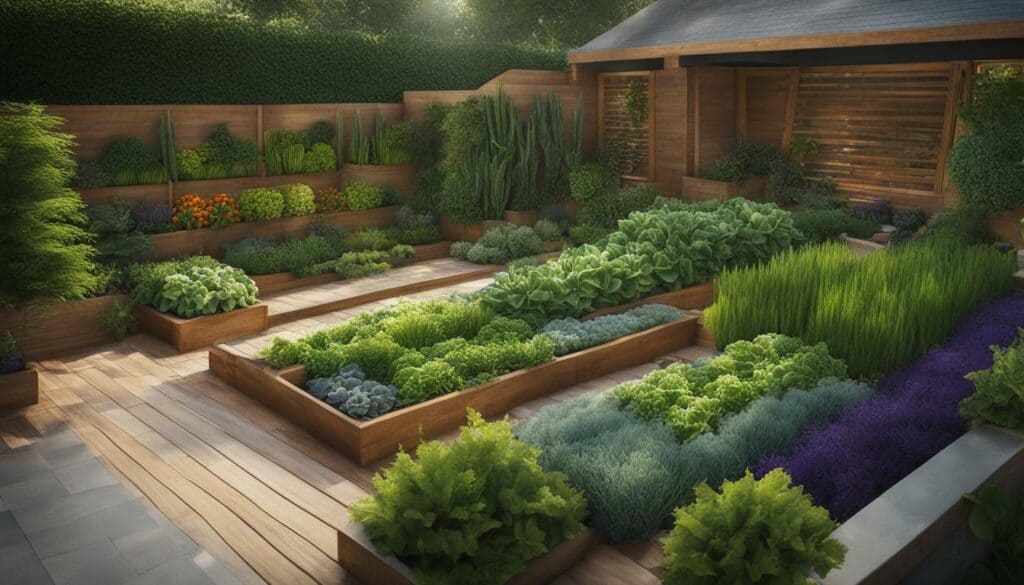
Considering Companion Plants for Pest Control and Pollination
Considering companion plants in your beginner garden can help with pest control and attract beneficial pollinators. Companion planting involves placing certain plants together so that they can benefit each other in some way. Some combinations of plants can help to repel pests, while others can attract pollinators like bees and butterflies.
For example, planting marigolds alongside your vegetable plants can help to deter pests like aphids and whiteflies. Marigolds have a distinct scent that many pests find unpleasant, so they may be less likely to attack your other plants. In addition to marigolds, other flowers like nasturtiums and alyssum can also help to repel pests.
When choosing companion plants, it’s important to consider the specific needs of your vegetable plants. For example, planting beans alongside corn can be beneficial because beans fix nitrogen in the soil, which can help to improve the growth of corn. However, planting beans alongside onions can be detrimental because onions release a chemical that can inhibit the growth of beans.
Another benefit of companion planting is that it can attract beneficial pollinators to your garden. Bees and butterflies are important for pollinating many vegetable plants, which can help to ensure a high yield. Plants like lavender, borage, and milkweed can help to attract these beneficial pollinators.
In addition to selecting companion plants, it’s also important to carefully plan the layout of your garden. Be sure to consider the height and spacing of your plants so that they can grow and thrive without competing for resources.
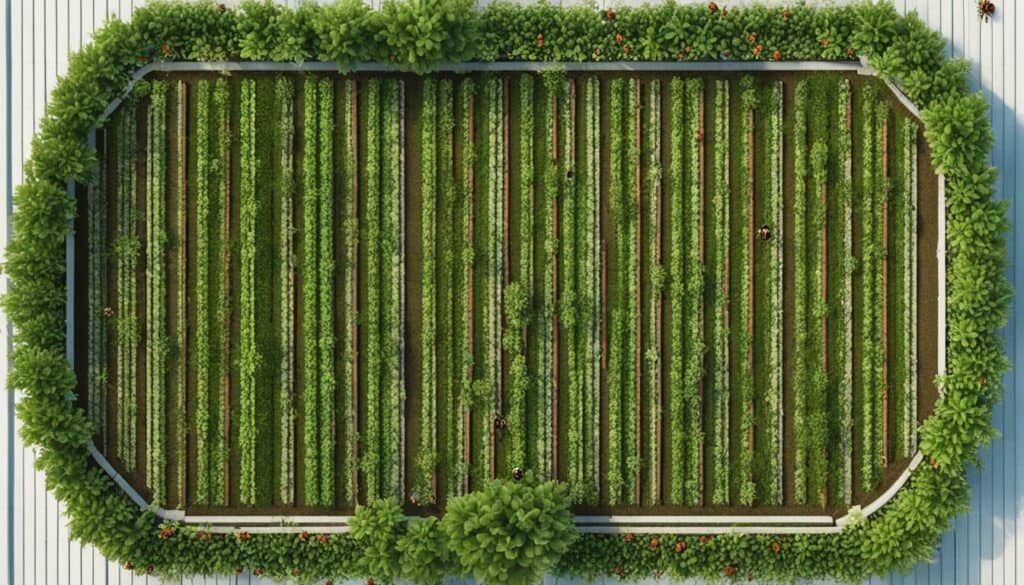
Starting Small and Gradually Expanding
Starting with a small garden plot and gradually expanding is a wise approach for first-time gardeners. It allows for easier maintenance and greater understanding of plant needs. As a beginner gardener, I found it helpful to have a gardening mentor or experienced family member to provide guidance during the planning and growing process.
When it comes to space, a traditional row garden or raised beds and containers can be used to grow vegetables and fruits. It is recommended to provide vegetables with at least 6 hours of full sun per day, although some plants like lettuce may require partial shade. Soil quality is important, and adding compost or organic fertilizer can help improve it. Watering needs can be met through rainwater catchment systems or soaker hoses.
| Gardening Tools for Beginners | |
|---|---|
| Tiller | Used for breaking up soil |
| Spade | For digging and moving soil |
| Garden Fork | Used for aerating soil and removing weeds |
| Soaker Hoses | For even watering and conserving water |
| Hoe | For cultivating the soil and removing weeds |
| Hand Weeder | For removing weeds from tight spaces |
| Wheelbarrow | For moving soil, plants, and other materials |
Essential gardening tools include a tiller, spade, garden fork, soaker hoses, hoe, hand weeder, and wheelbarrow. Keeping a garden journal can help with planning and record-keeping. When planning a vegetable garden, it is important to consider the first and last frost dates in the area. Selecting vegetables that are easy to grow and appropriate for the climate is recommended. Lettuce, green beans, radishes, tomatoes, zucchini, peppers, beets, carrots, chard, spinach, kale, and peas are some of the easiest vegetables to grow for beginners.
The size of the garden can vary, with a 10′ x 10′ garden being a manageable size for beginners. Planning the layout and considering the sunlight requirements of different plants is crucial. Companion planting can be employed to provide natural pest control and attract pollinators.

Remember, starting small and gradually expanding is a smart approach for beginner gardeners. By following these simple tips and guidelines, you can create a beautiful and bountiful garden in no time!
Conclusion
In conclusion, with the right planning, tools, and plant choices, beginner gardeners can quickly develop their skills and create thriving gardens. When starting out, it’s important to select an appropriate location for your garden and take into consideration factors such as sunlight exposure and soil quality. By using the right tools, such as a tiller and soaker hoses, you can ensure your garden is properly maintained.
In addition, selecting the right vegetables for your garden can contribute to your success. Vegetables such as lettuce, green beans, radishes, and tomatoes are easy to grow and maintain. It’s also important to keep a garden journal to track progress and consider companion planting techniques to improve pest control and pollination.
The Benefits of Starting Small
Starting small is another essential aspect of successful gardening. By beginning with a small garden plot, you can better understand the needs of your plants and properly maintain them. As you gain experience, you can begin to expand your garden and experiment with different plant varieties and designs.
Gardening can be an exciting and rewarding project, providing fresh and delicious produce while enjoying the numerous benefits of gardening. By following these guidelines and committing to the process, beginner gardeners can quickly develop their skills and create thriving gardens.
FAQ
Q: How much space do I need for a beginner vegetable garden?
A: The amount of space needed for a beginner vegetable garden depends on the number and types of vegetables you want to grow. As a general rule, start with a small plot of about 10 square feet and gradually expand as you gain experience.
Q: What are the key considerations when selecting a site for my vegetable garden?
A: When selecting a site for your vegetable garden, choose a location with adequate sunlight exposure (at least 6 hours of direct sunlight per day) and well-drained soil. Avoid areas with excessive shade, poor drainage, or competition from tree roots.
Q: What gardening tools do I need as a beginner?
A: Essential gardening tools for beginners include a tiller or garden fork for preparing the soil, a spade for digging, and soaker hoses for efficient watering. These tools will help you get started and maintain your garden effectively.
Q: Why should I keep a garden journal?
A: Keeping a garden journal is highly recommended for beginners. It allows you to track important information such as plant placement, seed receipts, and notes on what worked well. It serves as a valuable reference for future planning and helps you learn from your gardening experiences.
Q: Which vegetables are easy to grow for beginners?
A: Easy-to-grow vegetables for beginners include lettuce, green beans, radishes, tomatoes, zucchini, peppers, beets, carrots, chard, spinach, kale, and peas. These vegetables are relatively low-maintenance and can be grown successfully by beginners with proper care.
Q: How can I meet the specific requirements of each vegetable?
A: Meeting the specific requirements of each vegetable involves proper soil preparation, regular watering, appropriate fertilization, and pest control. It’s important to follow recommended guidelines for each plant to ensure successful growth and yield.
Q: Why should I consider companion plants in my garden?
A: Companion plants can help with pest control and attract pollinators to your garden. Certain plants have natural abilities to repel pests or attract beneficial insects, which can help protect your vegetables and improve pollination for better harvests.
Q: Is it better to start small and gradually expand my garden?
A: Yes, starting small and gradually expanding is a wise approach for first-time gardeners. It allows you to focus on a manageable area, gain experience, and learn from your gardening endeavors. As you become more confident and skilled, you can expand your garden and try new plants and designs.
What Are Some Success Secrets I Should Know as a Beginner Gardener?
As a beginner gardener, it’s essential to learn some green thumb gardening success secrets. Start by understanding your specific plant’s needs, providing adequate sunlight, water, and nutrient-rich soil. Cultivate patience and develop a routine for regular maintenance. Don’t forget to research the best planting techniques and pest control methods. With time and dedication, you’ll see your garden flourish.
Source Links
- https://www.almanac.com/vegetable-gardening-for-beginners
- https://www.amodernhomestead.com/garden-planning-for-beginners/
- https://gardenerspath.com/how-to/beginners/first-vegetable-garden/
- https://www.almanac.com/over-20-vegetable-garden-layout-ideas
- https://growitbuildit.com/planning-a-vegetable-garden/
- https://gardening.org/5-ways-to-plan-your-garden-layout-and-how-to-do-it/
- https://www.azurefarmlife.com/farm-blog/essential-garden-tools-for-beginners
- https://www.almanac.com/gardening-tools-guide
- https://porchdaydreamer.com/essential-garden-tools/
- https://preparednessmama.com/keep-a-garden-journal/
- https://cottageatthecrossroads.com/how-to-set-up-a-garden-journal/
- https://themicrogardener.com/why-keep-a-garden-journal-ideas-how-to-use/
- https://www.bhg.com/gardening/vegetable/vegetables/planning-your-first-vegetable-garden/
- https://shiftingroots.com/10-easy-vegetables/
- https://savvygardening.com/vegetable-garden-planner/
- https://savvygardening.com/4×8-raised-bed-vegetable-garden-layout/
- https://www.almanac.com/companion-planting-guide-vegetables
- https://gardening.org/best-companion-plants-to-grow-for-natural-pest-control/
- https://homesteadandchill.com/benefits-companion-planting-chart/
- https://www.purdue.edu/hla/sites/yardandgarden/advice-for-first-time-gardeners-start-small/
- https://www.almanac.com/small-vegetable-garden-plans-and-layouts
- https://www.bhg.com/gardening/yard/garden-care/ten-steps-to-beginning-a-garden/
- https://content.ces.ncsu.edu/home-vegetable-gardening-a-quick-reference-guide
- https://www.gardengatemagazine.com/review/vegetable-garden-ideas/

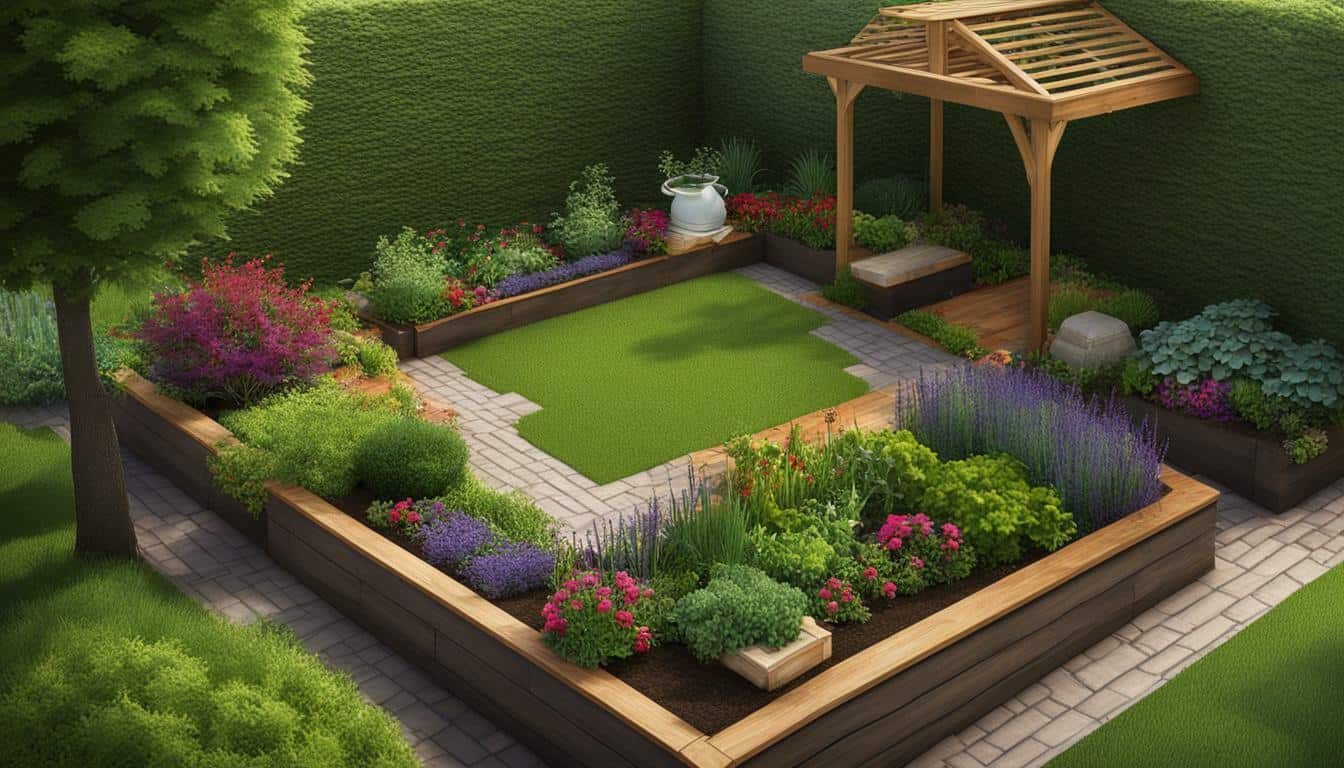



Leave a Reply